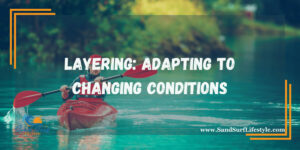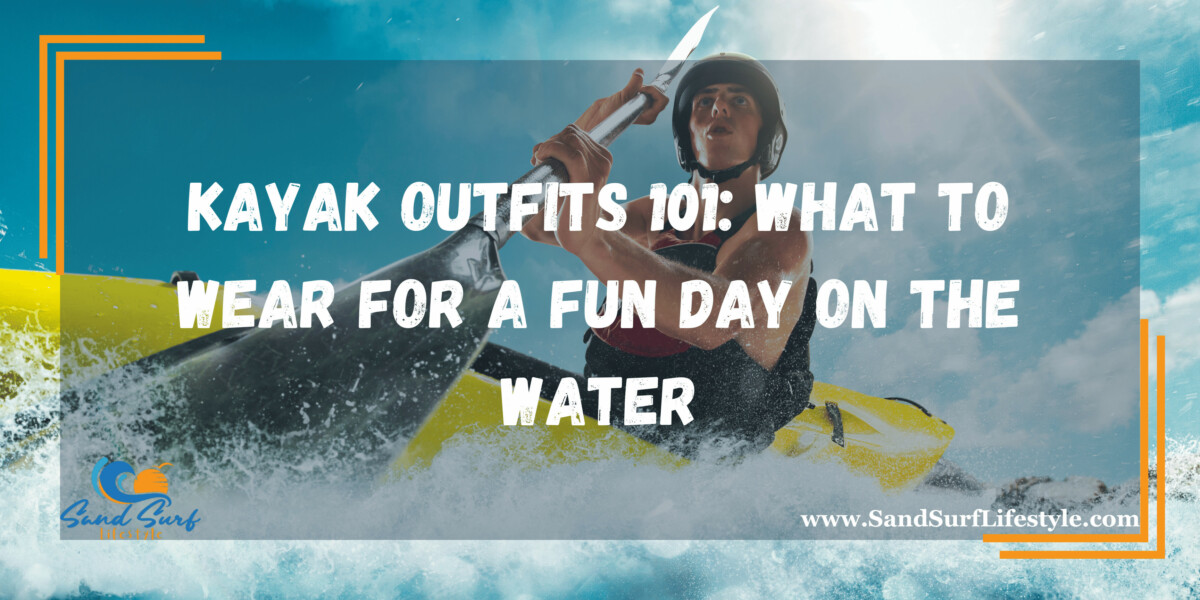Kayaking is a thrilling water activity that connects us with nature’s beauty and allows us to explore serene waterways. Whether you’re a seasoned paddler or a newbie looking to embark on your first kayaking adventure, what you wear can significantly impact your comfort, safety, and overall experience.
Base Layers: The Foundation of Comfort

Before embarking on a kayaking adventure, paying careful attention to your attire is paramount. A solid foundation begins with your choice of base layers, a critical element in ensuring a comfortable and enjoyable experience. These base layers serve several vital functions that enhance your overall paddling journey.
Firstly, base layers play a pivotal role in regulating your body temperature. Kayaking often involves exposure to varying weather conditions, and having the right base layer can help keep you warm in cooler temperatures and cool when it’s hot outside. Moisture-wicking and quick-drying fabrics, such as synthetic materials or merino wool, are ideal for this purpose. They efficiently move sweat away from your skin, preventing discomfort and potential health issues associated with prolonged exposure to damp clothing.
Furthermore, these fabrics are superb at moisture management, making sure you stay dry even when you’re exerting yourself and working up a sweat during intense paddling sessions. This moisture-wicking capability not only adds to your comfort but also plays a crucial role in preventing chafing, which can be a source of considerable discomfort during extended kayaking trips.
To learn about choosing the best life vest for kayaking, check out this article.
Top Wear: Shirts and Jackets
Selecting the right upper body attire for kayaking is a crucial aspect of ensuring both comfort and safety on the water. Your choice should be guided by the prevailing weather conditions and the specific demands of your kayaking adventure.
On warm, sunny days, it’s essential to wear a lightweight, moisture-wicking shirt with UV protection. This type of shirt serves a dual purpose: it keeps you cool and shields your skin from the harmful effects of the sun’s rays. The moisture-wicking fabric efficiently manages sweat, ensuring you stay comfortable even when the sun is blazing down. UV protection is critical for safeguarding your skin from sunburn and long-term sun damage.
Conversely, when kayaking in cooler weather or when there’s the potential for getting wet, a waterproof and breathable jacket is indispensable. Look for a jacket designed specifically for paddling, as it will have features tailored to the sport. These jackets are engineered to keep water out, ensuring you stay dry in wet conditions. Simultaneously, they allow moisture to escape, preventing you from getting sweaty and clammy inside your jacket.
Bottom Wear: Shorts or Pants
Your choice of bottom wear for kayaking is a decision influenced by both the prevailing weather conditions and the specific environment you plan to paddle in. It’s a crucial consideration as it directly affects your comfort and protection on the water.
On warm and sunny days, opting for a pair of quick-drying shorts is an excellent choice. These lightweight shorts offer comfort and freedom of movement, allowing you to paddle without hindrance. The quick-drying feature ensures that if you do get wet from splashes or paddle drips, your shorts won’t stay soggy for long.
However, when kayaking in cooler weather or if you anticipate encountering unpredictable conditions, it’s prudent to wear neoprene or waterproof pants. These pants provide essential insulation, helping to keep you warm when the temperatures drop or when you’re splashed with cold water. Furthermore, their waterproof nature ensures that you remain dry even in rainy or wet conditions. This is especially important for preventing hypothermia, as wet clothing can quickly sap your body heat.
Footwear: Protecting Your Feet
Feet are often overlooked when preparing for kayaking, but they play a critical role in your overall comfort and safety. Protecting your feet is essential, as wet feet can lead to discomfort, blisters, and even hypothermia in cold waters.
Many experienced kayakers prefer water shoes or neoprene booties as their footwear of choice. These specialized shoes offer several advantages. First and foremost, they provide excellent grip on slippery surfaces, such as wet rocks or the floor of your kayak. This grip is crucial for stability when entering or exiting your kayak and when navigating challenging terrain.
Water shoes and neoprene booties are designed to allow water to drain quickly. This feature prevents your feet from staying soaked, which can lead to discomfort and blisters. Furthermore, they’re typically snug-fitting to minimize the risk of blisters and provide support during long paddling sessions.
Headwear: Sun Protection and Visibility

While preparing for a kayaking adventure, it’s easy to overlook the importance of headwear, but this aspect of your attire is critical for both sun protection and visibility. Your choice of headwear can significantly impact your comfort and safety on the water.
On sunny days, a wide-brimmed hat or a paddling-specific cap becomes your best friend. These options provide essential sun protection, shielding your face from harmful UV rays. Sunburn is a real concern when you’re out on the water for extended periods, and a wide-brimmed hat or cap acts as a barrier, helping prevent sunburn and skin damage.
In contrast, if you’re kayaking in rainy or cold conditions, a neoprene hood or beanie is a valuable addition to your attire. Not only do they provide insulation to keep you warm, but they also help keep you dry by preventing rain or splashes from reaching your head and ears. Staying warm and dry in adverse weather conditions is crucial for your comfort and safety.
Moreover, for low-light conditions or enhanced visibility, consider a brightly colored hat or one with reflective elements. This ensures that you remain visible to other watercraft and enhances safety, particularly when kayaking in areas with boat traffic.
Accessories: Gloves and Sunglasses
Accessories like gloves and sunglasses can significantly enhance your kayaking experience, ensuring both comfort and safety during your time on the water.
When paddling in cold water or chilly weather, wearing gloves is advisable. Neoprene gloves are an excellent choice as they provide insulation while allowing you to maintain dexterity, crucial for gripping your paddle effectively. Cold, wet hands can quickly become numb and affect your ability to control your kayak. Neoprene gloves help prevent this discomfort and maintain your paddle control, ensuring a safer and more enjoyable kayaking experience.
Sunglasses are another essential accessory for kayaking. Opt for a good pair of polarized sunglasses to protect your eyes from the sun’s glare reflecting off the water. This glare can be not only uncomfortable but also impair your vision, making it harder to navigate and fully appreciate the beauty of your surroundings. Polarized sunglasses improve visibility, reduce eye strain, and enhance your overall kayaking experience.
Life Jackets: Safety First
While technically not attire, a life jacket is undoubtedly one of the most critical pieces of equipment for kayaking. It goes beyond being a mere accessory; it’s a lifesaver. Wearing a life jacket is not only a safety requirement but also a responsible choice that can make a profound difference in your well-being on the water.
A properly fitting life jacket is crucial for your safety. It should be appropriate for kayaking and designed to allow unrestricted movement for paddling while providing buoyancy. Ensure that it fits snugly, with all buckles fastened securely. It’s essential that the life jacket doesn’t ride up or impede your ability to move your arms, as this can be a significant hindrance while kayaking.
Some kayakers prefer inflatable life jackets for their comfort and convenience. These life jackets are less bulky, making them more comfortable to wear for extended periods. They provide buoyancy by inflating when needed, either automatically upon submersion or manually through a pull-cord mechanism. However, it’s crucial to maintain and regularly inspect inflatable life jackets to ensure they function correctly in emergencies.
Dry Suits: Ideal for Cold Water Paddling
For those who are drawn to the allure of kayaking in frigid waters, especially during the colder seasons, a dry suit is nothing short of a game-changer. Dry suits are specifically engineered to keep you completely dry even when submerged in icy water, providing a level of insulation and protection that’s unmatched by other kayaking attire.
Dry suits are constructed from waterproof and breathable materials that create a watertight seal, keeping water out while allowing moisture and sweat to escape. This design ensures that you stay dry and comfortable throughout your kayaking adventure, even in the harshest conditions.
One of the most significant advantages of dry suits is their superior insulation. They provide a thermal barrier that helps to retain your body heat, preventing hypothermia and allowing you to comfortably enjoy kayaking in extreme cold.
However, it’s essential to note that dry suits can be relatively expensive compared to other kayaking gear. Therefore, before investing in one, consider your kayaking goals and the types of conditions you plan to encounter. If you’re committed to extreme kayaking adventures in cold waters, a dry suit is an invaluable investment in your safety and comfort.
Layering: Adapting to Changing Conditions

Kayaking enthusiasts are well aware of the unpredictable nature of weather on the water. Being prepared for changing conditions is essential to ensure your comfort and safety during your kayaking adventures. Layering is the key to staying comfortable and adaptable to the ever-shifting environment.
Begin with a moisture-wicking base layer, typically made from synthetic materials or merino wool. This base layer serves as a foundation by efficiently wicking away sweat from your skin, keeping you dry, and preventing chafing during strenuous paddling. It also helps regulate your body temperature, which is essential for comfort.
As you venture out into varying conditions, add insulation layers like fleece or synthetic mid-layers. These materials provide warmth and insulation, crucial when the temperatures drop or when you encounter cool breezes on the water. The beauty of this layered approach is that you can easily adjust your attire by adding or removing layers as needed, allowing you to stay warm without overheating.
Lastly, finish your layering system with a waterproof and breathable outer layer. This outer shell protects you from rain, wind, and splashes while allowing moisture to escape, ensuring you remain dry and comfortable regardless of the weather.
Safety Gear: Additional Considerations
Beyond the realm of clothing, your safety on the water also relies on a few essential pieces of gear. These items are instrumental in emergencies and can enhance your overall kayaking experience.
First and foremost, carry a whistle with you on every kayaking trip. A whistle is a universally recognized distress signal and can be a lifesaver in situations where you need assistance. It’s a small, lightweight, and essential tool that should be within easy reach, and attached to your life jacket or clothing.
A waterproof pouch or dry bag is another vital accessory. These bags keep your essentials like a phone, map, or snacks dry and easily accessible. In case of unexpected rain or splashes, you can have peace of mind knowing your crucial items are protected.
For kayakers venturing into whitewater rapids, a helmet is a necessary safety measure. Whitewater kayaking can be exhilarating but also risky. A helmet provides head protection in case of capsizing or collisions with rocks and other obstacles. It’s a crucial piece of gear that can prevent head injuries and ensure your safety during more challenging paddling adventures.
Conclusion
In the world of kayaking, choosing the right attire is as important as selecting the right kayak and paddle. Your clothing should not only keep you comfortable but also safe in the ever-changing conditions you may encounter. Whether you’re a casual paddler enjoying a leisurely day on the water or an adventurous kayaker tackling challenging rapids, the right attire ensures you can enjoy your kayaking journey to the fullest. So, gear up, stay safe, and let the waters lead you on unforgettable adventures.
Please note that the contents of this blog are for informational and entertainment purposes only and should not be construed as legal advice. Any action taken based on the information provided in this blog is solely at your own risk. Additionally, all images used in this blog are generated under the CC0 license of Creative Commons, which means they are free to use for any purpose without attribution.

